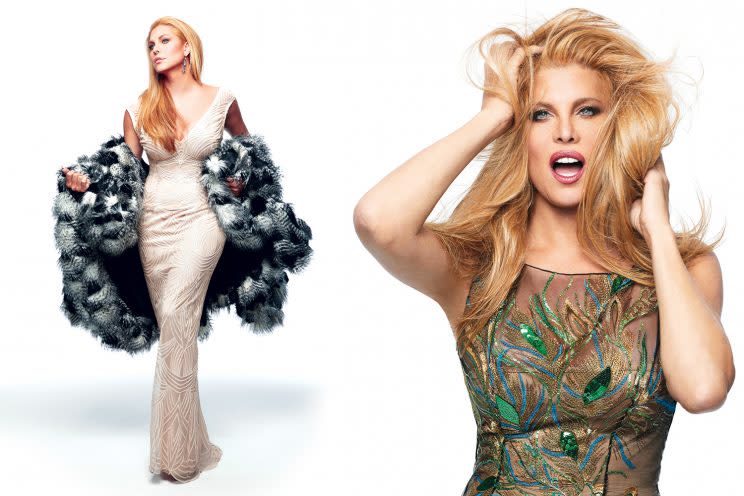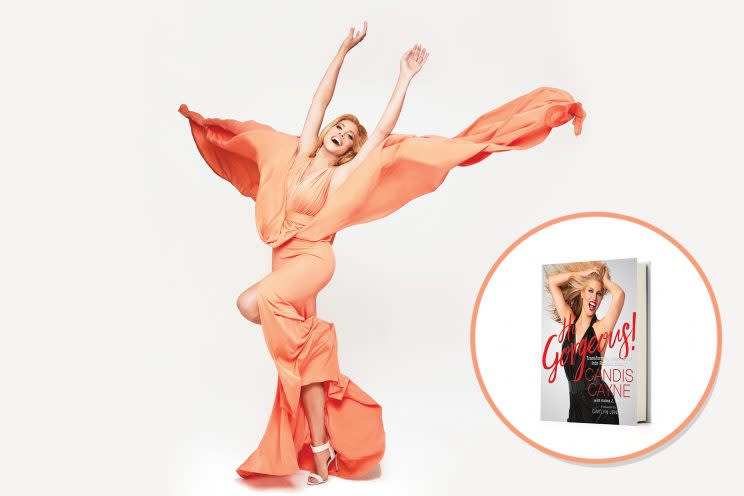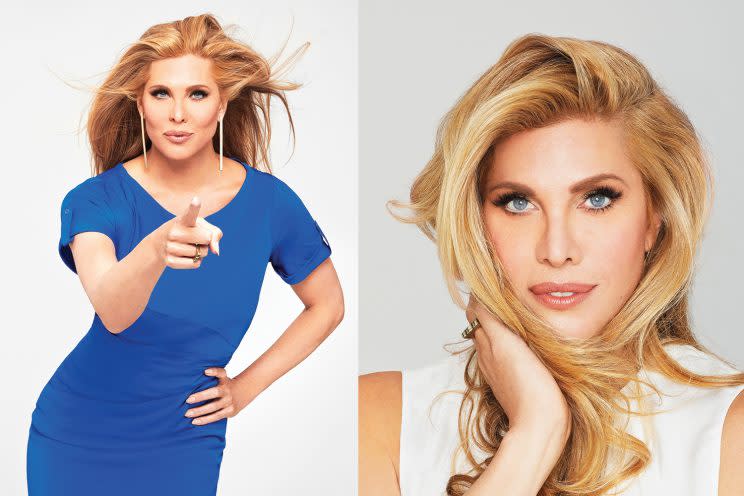Trans Star Candis Cayne on Beauty: ‘When I Started Doing Makeup, There Was No YouTube’

Long before Candis Cayne high-kicked her way into the collective consciousness on the short-lived but impactful I Am Cait as Caitlyn Jenner’s BFF (or “sidekick” or “love interest,” depending on who wrote the story), the leggy transgender actress was out there, shaking up the status quo.
The Hawaiian native ruled New York City’s LGBT nightlife scene as a stunning drag performer throughout the ’90s, transitioning gradually, right before her audiences’ eyes. Then she got her big break, cast as Billy Baldwin’s transgender love interest in the mid-aughts series Dirty Sexy Money, becoming the first trans woman in history to have a recurring role in primetime. More roles followed, but none as major as when she landed on the reality show with Jenner, as her glamorous, mentoring friend.
Cayne, 46, had plenty of insights to share, after all — and now she’s compiled them for anyone who could benefit, in a book that’s part advice, part memoir, Hi Gorgeous! Transforming Inner Power Into Radiant Beauty. She spoke with Yahoo Beauty about the book, her career, and her Hollywood life, in honor of Pride month.

So what made you want to write a beauty book?
I was at DragCon [drag conference] a year ago and this beautiful girl said, “Oh, you’re so gorgeous,” and I said, “You are too!” And she was like, “No I’m not.” I was taken aback and thought: How does his beautiful girl not know how gorgeous she is? So I thought it would be a good idea to write a book for women of all ages and races and colors and genders to talk to them about radiating that inner beauty and having confidence in who they are. That’s the starting place, and once you have that starting place you can go from there. Also, I’ve been doing makeup and hair and outfits and clothing and styling and beauty for 25 years — on myself and sometimes on others — so I’ve garnered a big amount of knowledge on the subject.
How did you ever figure out beauty without YouTube?
[Laughs] When I was just starting to do makeup and discover who I was, there was no YouTube, there were no vloggers — you couldn’t log on and get a tutorial. I was basically looking at magazines, through the pages of Vogue, saying, “Oh, I love her makeup,” and then trying to re-create that — painstakingly in the beginning. And after a while I just had it down.
In the book, you include a photo of yourself the first time you were in drag — as well as many other old photos, even from when you were a young boy. What went into your decision to include them?
[The photo of] my first time in drag was from when I was in La Cage aux Folles in high school, before I graduated and moved to the mainland. I got into a wig and makeup and leotard and heels — my first time doing this whole look, and it was amazing. It was kind of the first spark for me. I put those pictures in because we all have a starting point. It’s not a pretty picture. It’s really rough around the edges. But the book, to me, talks about confidence in who you are. And for me, that started when I was a kid, [not] at the age of 24, when I started to transition. I wanted to include my entire life. Cutting off half my life didn’t make sense to me. I’m proud of the person I am, and I’m proud of the person I was and who I grew to be.
How has the role of makeup shifted for you as you’ve become more settled as a transgender woman?
When I first started performing in drag in New York City and would put on my makeup, it made me feel whole. I felt less whole when I’d wake up in the morning with no makeup and was just still myself at that point. So it was important to do all the right steps, like electrolysis and growing out my hair, to make me feel the way I felt inside. And when I decided to transition it was easier for me, because I did know how to do makeup at that point. Transitioning was an intense experience, and it was a time in my life when I was able to still work — I didn’t have any of those issues that a lot of trans people have where they tell the whole workforce and they have to maybe get fired, and they have all of these people at work who maybe don’t understand. I was in New York City. I was in my tribe. I was able to transition openly in front of an audience and tell them my stories.

You still perform for LGBT audiences and are in some ways entrenched in the world of drag. How has that changed for you since transitioning, and what is the actual difference, for those still confused about drag vs. gender?
Doing drag is when someone puts on a fabulous outfit, goes onstage, and performs, or goes out and is social. Mostly it is gay men who go out and do drag, and it’s just a part of gay culture. When you’re trans it’s gender identity. So a lot of people that I know who are trans perform, because that’s where [they came up]. A lot of girls are trans and are also performers. [Just like] there are a lot of trans people who don’t want to have anything to do with the stage and don’t want to be lumped into drag performance. To me, we’re all in drag. So I wouldn’t say that I’m a drag queen, because to me that’s a guy dressing up as a girl. But when I perform, and put on big hair and heels, I’m a trans drag artist.
You were doing four to five one-woman shows a week in NYC when you got the Dirty Sexy Money role. How did it change your life?
I got the role and I had no idea what it meant. I was supposed to be in two episodes but wound up being in all of both seasons because my character really hit home with a lot of viewers, and they liked my and Billy [Baldwin’s] chemistry. All I knew is that I got this role and they finally didn’t hire a cis woman or cis man to play a trans character. It didn’t really hit home to me until the episode started airing, and I was at some event, I think for HRC, and they were showing this clip of me and Donald Sutherland in the back of this limo and I tell him, “I’m the living, breathing epitome that nothing is impossible,” and the whole audience in this huge ballroom stood up and applauded. I’m getting chills talking about it! Because it was the first time that I realized this wasn’t just all about me — this was actually doing something to push society forward, to open doors for other people, to broaden other people’s perspectives.
I’m imagining it was a similar feeling with the impact of I Am Cait. What was it like be a part of the show?
The first season, there hadn’t been very many sightings of Cait yet. We went to go see American in Paris on Broadway … and I didn’t realize how huge it was going to be when we walked out into Times Square. There were at least 5,000 people everywhere you looked, with cameras and screaming Cait’s name. It was so surreal. I was like, “Well, this is going to be huge.” [Laughs] Then the show’s producers said it would be in 150 countries and, like, 40 different languages, so I was, like, so everyone around the world will know who Caitlyn is? Who we are? They were going to listen to trans stories that are so important, especially in countries where it’s illegal, like in [parts of] Africa … where they will just kill someone who is LGBT. So I Am Cait really did something to change the world and to put the word “trans” on people’s lips.
It’s no secret that your politics differ greatly from those of Caitlyn Jenner. Have you remained friends despite that?
I talk to Cait all the time, though we don’t see each other as much because we are both superbusy. The last season got very political and very intense and, like I told Larry King, I want to be that person that can have a fierce discussion — because there are certain things in life we don’t agree on — but after that’s over, you can put it down and play a round of golf. I’ve only played golf twice. [Laughs] But yes, we have discussions and we might even have an argument, but when it comes down to it, we’re friends. And that’s what’s really important.
She actually wrote the foreword to your book, and pointed out, notably, “Candis is beautiful. It’s not just her gorgeous hair (though she has that … my god, that hair!)” What’s your hair secret?
I wash it twice a week. I usually use Kiehl’s shampoo and conditioner. You don’t need that much, and in fact when half of the bottle is used I like to fill it up with water. On the third day if I’m feeling like it’s not happening, I like to use Mega Dust. It’s like a dry shampoo but it’s a root stiffener; it dries up your scalp and the first quarter inch of your hair so you have lift again, like a fresh blowout.
You’ve talked about being close with your parents and your brother — your twin! How important has it been to have such support in your life?
I knew they were going to accept me, because they loved me. I wrote them both a letter and said I’m trans and I’m going to start this transition. It was the second time I came out — the first time I thought I was gay — so they flew out to New York and they visited me to make sure my heart was OK, my head was OK. They were always all really supportive of everything I did, they came to see my shows, they were always right there if I had a problem and needed help, so that kind of allowed me to create this life for myself. And to people who don’t have that support system: You can still be anything you want to be. You have to have a dream, you have to work hard for it, and you have to center yourself around your family, your tribe, [whether or not] it’s your genetic family. You can have any dream that you set your heart to, as long as you work hard and you walk in love.
Read more from Yahoo Beauty + Style:
‘Wonder Woman’ Gal Gadot Feels ‘Very Sexy and Very Strong’ in Her Costume
Transgender Hero Janet Mock: ‘Glam Is a Gateway to Survival’
Follow us on Instagram, Facebook, and Pinterest for nonstop inspiration delivered fresh to your feed, every day. For Twitter updates, follow @YahooStyle and@YahooBeauty.

